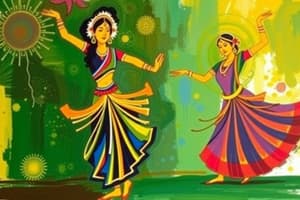Podcast
Questions and Answers
Who is the author of the Natyashastra?
Who is the author of the Natyashastra?
- Bharata Muni (correct)
- Dr. P.V. Rajamannar
- Ilang Adigal
- Uday Shankar
What is the name of the academy that recognizes eight classical dance forms?
What is the name of the academy that recognizes eight classical dance forms?
- Natyashastra Academy
- Indian Ministry of Culture
- Indian Education Ministry
- Sangeet Natak Academy (correct)
Which of the following is NOT a classical dance form recognized by the Sangeet Natak Academy?
Which of the following is NOT a classical dance form recognized by the Sangeet Natak Academy?
- Kathak
- Film Dance (correct)
- Chhau
- Bharatnatyam
Who is regarded as the Father of Modern Dance in India?
Who is regarded as the Father of Modern Dance in India?
Which classical dance form is primarily associated with the state of Tamil Nadu?
Which classical dance form is primarily associated with the state of Tamil Nadu?
What is the name of the ancient Tamil epic that describes Bharatanatyam?
What is the name of the ancient Tamil epic that describes Bharatanatyam?
What is the name of the solo artist in Bharatanatyam dance?
What is the name of the solo artist in Bharatanatyam dance?
What is the original name of Bharatanatyam dance?
What is the original name of Bharatanatyam dance?
What is the name of the Bharatanatyam dance piece?
What is the name of the Bharatanatyam dance piece?
Which style is associated with Bharatanatyam?
Which style is associated with Bharatanatyam?
Where are Bharatanatyam poses depicted?
Where are Bharatanatyam poses depicted?
Who is a renowned exponent of Bharatanatyam?
Who is a renowned exponent of Bharatanatyam?
What is the association of Bharatanatyam with Lord Shiva?
What is the association of Bharatanatyam with Lord Shiva?
What is the primary theme expressed in Bharatnatyam?
What is the primary theme expressed in Bharatnatyam?
Which of the following dance forms is also known as Dasiattam?
Which of the following dance forms is also known as Dasiattam?
What is the name of the text that regulates classical dance forms?
What is the name of the text that regulates classical dance forms?
Which state is primarily associated with the classical dance form of Kathak?
Which state is primarily associated with the classical dance form of Kathak?
What is the name of the ancient Tamil epic that describes Bharatanatyam by 2nd century CE?
What is the name of the ancient Tamil epic that describes Bharatanatyam by 2nd century CE?
Flashcards are hidden until you start studying
Study Notes
Classical Dance in India
- Classical dance is distinguished from folk dance due to its regulation by the rules of the Natyashastra.
- The Natyashastra is a Sanskrit text on the performing arts written by Bharata Muni.
Sangeet Natak Academy
- The Sangeet Natak Academy recognizes eight classical dances.
- It was set up by the Indian Education Ministry on 31 May 1952 and became functional the following year, with Dr. P.V. Rajamannar as its first chairman.
- Dr. Rajendra Prasad, the first President of India, inaugurated it on 28 January 1953 in a special function held in the Parliament House.
Classification of Classical Dances
- The Sangeet Natak Academy recognizes eight classical dances, including:
- Bharatnatyam (Tamil Nadu)
- Kathak (Uttar Pradesh)
- Kathakali (Kerala)
- Kuchipudi (Andhra Pradesh)
- Odissi (Odisha)
- Manipuri (Manipur)
- Mohiniattam (Kerala)
- Satthriya (Assam)
Bharatnatyam
- Bharatnatyam is a classical dance that expresses South Indian religious themes and spiritual ideas, particularly of Shaivism, Vaishnavism, and Shaktism.
- It is dedicated to temples and was earlier known as Sadir or Dasiattam.
- Ekaharya is the solo artist in Bharatanatyam dance.
- Alarippu is a dance piece from Bharatanatyam.
- Kalakshetra and Vazhuvoor are styles associated with Bharatanatyam.
- Theoretical foundations of Bharatanatyam have been found in Natya Shastra.
- Tillana is a term associated with the Bharatanatyam dance form.
- A Nattuvanar conducts a Bharatanatyam dance recital.
- Bharatanatyam poses are depicted on the gopurams of the Chidambaram temple.
Classical Dance in India
- Classical dance is distinguished from folk dance because it has been regulated by the rules of the Natyashastra.
- The Natyashastra is a Sanskrit text on the performing arts written by Bharata Muni.
Sangeet Natak Academy
- The Sangeet Natak Academy recognizes eight classical dances.
- It was set up by the Indian education ministry on 31 May 1952 and became functional the following year.
- Dr. Rajendra Prasad, the first President of India, inaugurated it on 28 January 1953.
Classical Dance Forms
- Bharatnatyam: originated in Tamil Nadu, expresses South Indian religious themes and spiritual ideas, particularly of Shaivism, Vaishnavism, and Shaktism.
- Kathak: originated in Uttar Pradesh.
- Kathakali: originated in Kerala.
- Kuchipudi: originated in Andhra Pradesh.
- Odissi: originated in Odisha.
- Manipuri: originated in Manipur.
- Mohiniattam: originated in Kerala.
- Satthriya: originated in Assam.
Bharatnatyam
- Bharatnatyam was originally performed in the temples of Tamil Nadu by the Devadasis and is also known as Dasiattam.
- Ekaaharya is the solo artist in Bharatanatyam dance.
- 'Alarippu' is a dance piece from Bharatanatyam.
- Kalakshetra and Vazhuvoor styles are associated with Bharatanatyam.
- Theoretical foundations of Bharatanatyam have been found in Natya Shastra.
- 'Tillana' term is associated with the Bharatanatyam dance form.
- A 'Nattuvanar' conducts a Bharatanatyam dance recital.
- Bharatanatyam is the first of India's traditional dance to be refashioned as a theatre art and to be exhibited widely both at home and abroad.
Important Exponents of Bharatanatyam
- Swapna Sundari
- Lakshmi Viswanathan
- Rukmini Devi Arundale: a Padma Bhushan awardee, legendary Bharatanatyam exponent, theosophist, and founder of the Kalakshetra Dance School.
- Bala Saraswati
- Yamini Krishnamurthy
Studying That Suits You
Use AI to generate personalized quizzes and flashcards to suit your learning preferences.





